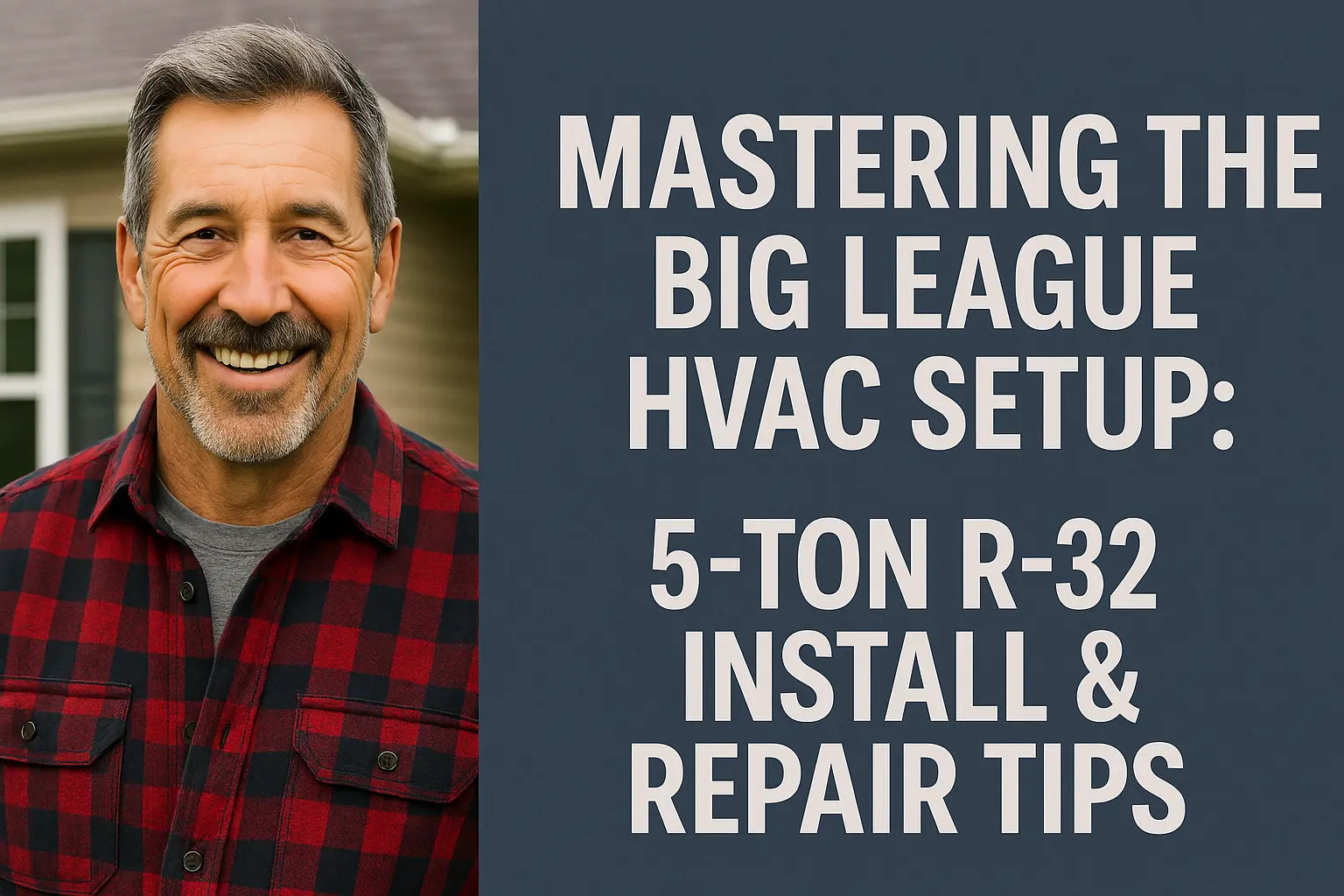👋 Hello from Mike:
Hey there, neighbor. I’m Mike Sanders—your go-to HVAC guy who doesn’t believe in upsells or confusing jargon. If you’ve got a big ol' 5-ton R-32 air conditioner and gas furnace system or you’re thinking of installing one, I’ve got your back. These units are beasts, but they need to be treated right to keep your house cool in July and cozy in January.
I wrote this guide with homeowners like you in mind—folks who want to understand how things work, fix what they can, and know when to call for help. So grab a coffee (or a cold one), and let’s get into it.
🔧 Why 5-Ton R-32 Systems Are Worth the Effort
These systems are powerful, energy-efficient, and better for the planet thanks to that R-32 refrigerant. That stuff has about a third the Global Warming Potential of R-410A and works even better in high-capacity systems like the 5-ton models.
✅ Better efficiency = lower bills
✅ R-32 = eco-friendlier
✅ High cooling & heating power = perfect for larger homes (2,500–3,200 sq ft)
Learn more about why R-32 is gaining ground across the U.S. HVAC market from Daikin.
🛠️ Part 1: Installation Must-Knows
📍 Location, Location, Location
Make sure your outdoor unit is:
-
On a solid, level surface
-
At least 12 inches from walls
-
Away from debris or obstructions
For the furnace, you want:
-
A well-ventilated mechanical room
-
Proper duct sizing to match 5-ton airflow (typically 2,000 CFM)
-
Combustion air access per ASHRAE’s ventilation guidelines
🧰 Ductwork Compatibility
A 5-ton unit needs a return duct that’s at least 24 inches wide and a supply trunk line around 20 inches. Undersized ducts = noisy system, inefficiency, and premature wear.
HVAC.com has a great guide on duct sizing you can use as a reference.
⚡ Electrical and Fuel Hookups
-
Furnace: Requires dedicated 120V line, plus proper gas pressure
-
AC unit: Needs 240V, often on a 50-amp breaker
-
Thermostat: Compatible with multi-stage or smart systems
Make sure your setup meets local code—every town’s a little different. Some towns require permits and inspections post-installation, which you can often check on your city or county building department’s site.
🚩 Part 2: Common Installation Mistakes to Avoid
🔄 Reusing Old Lines
If you're replacing an older system, don’t reuse refrigerant lines unless you flush them with a R-32-compatible cleaner. Leftover oil from R-410A can contaminate the system.
🧯 Ignoring Ventilation Safety
Gas furnaces need fresh air for combustion and clear venting for carbon monoxide. If the exhaust pipe is undersized or obstructed, it’s a serious hazard.
Learn about carbon monoxide safety and ventilation from the CDC.
🪛 Skipping the Load Calculation
Bigger isn’t always better. If you install a 5-ton system without doing a Manual J load calc, you risk short cycling, humidity problems, and higher energy bills. This should be done by a licensed HVAC tech, or use this Manual J calculator to get a ballpark figure.
🔍 Part 3: Troubleshooting the 5-Ton R-32 System Like a Pro
🔥 Problem: Furnace Turns On But No Heat
✅ Check the thermostat settings
✅ Make sure gas valve is open
✅ Inspect flame sensor (clean it with steel wool)
✅ Look for flashing error codes on the control board
Here’s a guide to decoding Goodman furnace error lights.
❄️ Problem: AC Runs But Blows Warm Air
-
Is the outdoor fan spinning?
-
Is the condenser coil dirty?
-
Any signs of a refrigerant leak?
Check your R-32 pressure levels against manufacturer specs—low pressure = possible leak. And yes, R-32 can be recharged, but only by an EPA-certified tech.
💨 Problem: Weak Airflow
✅ Check your air filter (replace every 30–90 days)
✅ Inspect return grilles for blockages
✅ Make sure blower motor is running at full speed
✅ Confirm ducts aren't kinked, collapsed, or undersized
You might need to bump up your blower speed settings, which is usually a DIP switch or ECM control adjustment. Check your model’s tech sheet.
📉 Problem: Short Cycling
Short cycling (starting/stopping rapidly) can cause wear and spike energy costs.
Root causes include:
-
Dirty condenser coil
-
Oversized unit (that’s where that load calc comes in again)
-
Faulty limit switch
-
Malfunctioning thermostat
🔁 Regular Maintenance Checklist
🗓️ Every 1–3 Months:
-
Replace air filters
-
Clear leaves/debris from outdoor condenser
-
Check thermostat batteries
🗓️ Annually:
-
Get a pro tune-up
-
Check refrigerant levels
-
Clean blower wheel and coil
-
Test for gas leaks and carbon monoxide
The EnergyStar HVAC maintenance checklist is a good one to print and stick to your furnace.
🧠 Smart Add-Ons for 5-Ton Systems
-
Wi-Fi thermostat (ecobee or Honeywell T10 recommended)
-
Air purifier with MERV 13 or higher
-
Smart leak detector near your condensate drain
-
Surge protector for the AC unit
These help you catch problems early and keep your system running longer.
👋 Final Thoughts from Mike
Whew, that was a lot, huh? But if you’ve made it this far, you’re already ahead of 90% of homeowners. You now know how to install, inspect, and troubleshoot your 5-ton R-32 AC and gas furnace system like a champ.
Remember, no shame in calling a pro when you're out of your depth—just make sure it’s someone honest and licensed. And hey, if you're shopping for a unit or just want to see what a fair price looks like, take a peek at the 5-ton R-32 systems over at The Furnace Outlet. Great prices, shipped fast, no funny business.
Want to know about carbon monoxide safety with 5-ton combos? Visit my guide: Silent But Deadly.
Until next time, keep the air flowing and the coffee brewing.
—Mike, Your Friendly HVAC Neighbor 👨🔧







